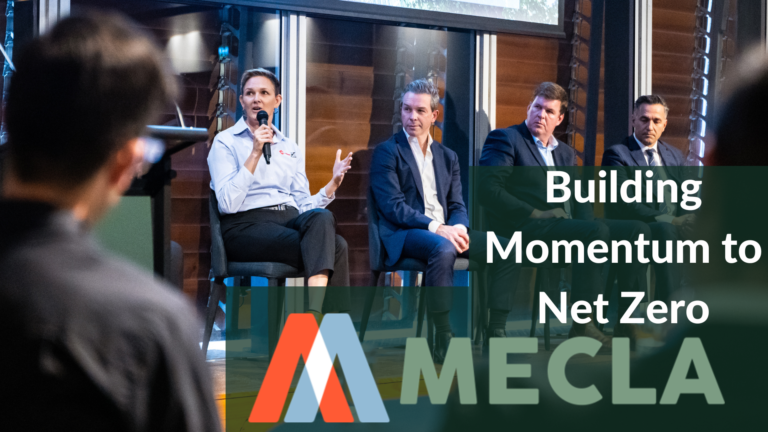
The building and construction industry’s journey to net zero emissions made a stopover in Sydney in May. At one of Australia’s most historic buildings, the old ‘Rum Hospital’ turned gold coin minting facility, dozens of people came together to discuss how to address some of the sector’s most intractable problems. Among those gathered at The Mint were CEOs of several ASX-listed companies, government officials and other participants of the built environment’s ecosystem. The occasion was to mark the first anniversary of the Materials & Embodied Carbon Leaders’ Alliance, or MECLA, which aims to transform the sector to meet the decarbonisation targets laid out in the Paris Agreement.
The case for change is strong. The built environment sector is responsible for a quarter of Australia’s carbon emissions. Construction materials alone make up 5-10% of Australia’s emissions. The construction sector employs almost 1.2 million people, illustrating its importance to the nation’s economy. It is what is called a “hard to abate” sector when it comes to reducing carbon emissions.
The impetus for founding MECLA stemmed from a realisation that it would need industry and government to work together to achieve the sector’s transition to net-zero carbon building materials. The sector’s issues, however, are too complex and difficult to be overcome by individual organisations, let alone at the speed that is required. This was also one of the main conclusions of the report “The Time is Now – Tackling Embodied Carbon in the Building and Construction Sector”, which was produced by WWF and Presync. And it coincided with a Lendlease report which posed the question: what is (really) stopping us from using low embodied carbon materials?
With the support of 42 Founding Partners from across the building and construction sector and funding from the NSW Government, MECLA set up working groups to address the key levers they had identified to drive change. And those groups have come up with a list of the most pressing questions, including:
- How to convince the manufacturing industry that there is sufficient demand for low embodied carbon building materials? It’s critical for the industry to pivot towards those materials.
- What is the best way for the sector to learn from each other about how to manage the climate transition in a non-competitive environment?
- How do we measure embodied carbon and benchmark different products against each other?
- What language is suitable when asking about the right design and the right materials for the buildings of our future? An estimated 60 percent of buildings by 2050 haven’t been built yet.
- How can we support manufacturers of materials such as steel, aluminium, cement and concrete to reduce carbon intensity? How can we make low carbon and innovative materials more visible?
There were, of course, many more questions. But let’s look at these in a little more detail.
If we want manufacturers to produce more low carbon building materials, we need to give them confidence that there will be enough demand in the market for these products. Some industries will find the transition easier than others. The cement and concrete industry, for example, has innovated in the last decade. It has developed cement alternatives and new products such as geopolymer concrete, which are widely available today. In other cases, the transition appears to be prohibitive, or the technology is not yet available at large scale. But what they have in common is this: if manufacturers see constant, clearly defined demand for local, low embodied carbon building materials, they will act. So how can we demonstrate this demand? MECLA is currently exploring with the NSW and other state governments a publicly available target for reduced embodied carbon in building materials set by head contractors as a pre-requisite when tendering for government work.
This leads us to another question: How do we measure, disclose and account for the embodied carbon in our buildings? This is a crucial step. It needs to involve everybody in the system. That includes small innovative material developers, large manufacturers, individual home builders, large infrastructure developers, architects, engineers to head contractors, financial investors and government and standard setting agencies.
We need to know how much embodied carbon goes into a residential tower or office building, a new major road project or rail infrastructure for the next generation of commuters. To do that, we need to know how much carbon goes into each part of these structures, such as the steel and cement foundations, the glass windows, the timber panelling, the aluminium façade, and all the other the systems that keep a building going. And we need to find out how new and innovative, lower embodied carbon products compare to established materials – not just from the point of view of production, but also from a performance. MECLA will shortly release a discussion
paper for feedback and information purposes that defines relevant embodied carbon benchmarking methods for materials, buildings, and infrastructure already available in Australia.
Developing a common language is another key element. Being able to specify what we want means using the right language. An example where a single word can have too many meanings attached to it is ‘Green’. Definitions for what constitutes a ‘green’ building product are not as clearly defined and regulated as the square meterage for a chicken to have its eggs labelled free range. If you ask ten people what ‘green’ means to them, you will likely receive ten different answers ranging from made with low to zero embodied carbon, made with some to 100% recycled or reused content, ethically sourced to responsibly made, from partially or fully offset or made with renewable energy or maybe even painted green. MECLA has released a Dictionary of Carbon which provides common language definitions for more than 60 popular carbon-related terms used in the built environment and related industries. Inclusions range from absolute zero carbon and adaptive reuse to upfront embodied and whole-life carbon.
While some working groups are assessing how we can best demonstrate demand for low embodied carbon materials, others are trying to figure out how best to provide these materials when they are required and at a competitive cost. Working group members share – in a non-/pre-competitive environment – best practices and case studies, while educating themselves and others in the industry about current developments and methods. MECLA’s website contains a growing library of case studies, brochures on low embodied carbon building materials and other resources. The working groups host regular knowledge sharing events, known as MECLA Spotlight events, that are freely available.
All of these issues matter greatly – individually and as a whole. Any one solution won’t change the system if the others are not in place. Working collaboratively across these topics is central to achieving the net zero carbon goals that governments and industry organisations are setting themselves. Increasingly, it also affects companies’ ability to attract investment, including from superannuation funds and government procurement agencies, which are putting much more scrutiny on the issues.
Open collaboration, a solid governance structure, knowledge sharing and transparency, along with robust discussions, have been successful for MECLA, which has more than tripled its partners to over 130 in just one year. The alliance continues to grow and is moving to its next phase – with funding from several state governments and industry organisations – that will take the collaborative format to a national level.
In this new phase, MECLA will build on the foundations it has already laid and hone in on cementing carbon targets into policies, regulations and standards, rating schemes and project financing mechanisms. Concurrently, MECLA members will continue to work together to ask important questions about specifications of low carbon materials and future demand. These questions include how can we catapult these materials into the mainstream? How can embodied carbon become a factor in financial decision making and procurement terminology? And what else can we do to assist manufacturers in their transition to low embodied carbon materials?
We knew when we began MECLA that we had a strong case. We knew we had to change the system in order to transition the building and construction sector towards decarbonisation. We knew it was the right time to move ahead and we had the research to back it up. With just more than a year having passed, we can see that there is far more that we can achieve than we originally envisioned. And there are many more people and organisations who think the same as we do and want to be the engines of change.
As a CEO said at MECLA’s event at The Mint last May: “You’re either inside the tent talking about those real issues or outside the tent observing and it’s better to be inside the tent.

Kathy Verheyen
Senior Project Manager at MECLA